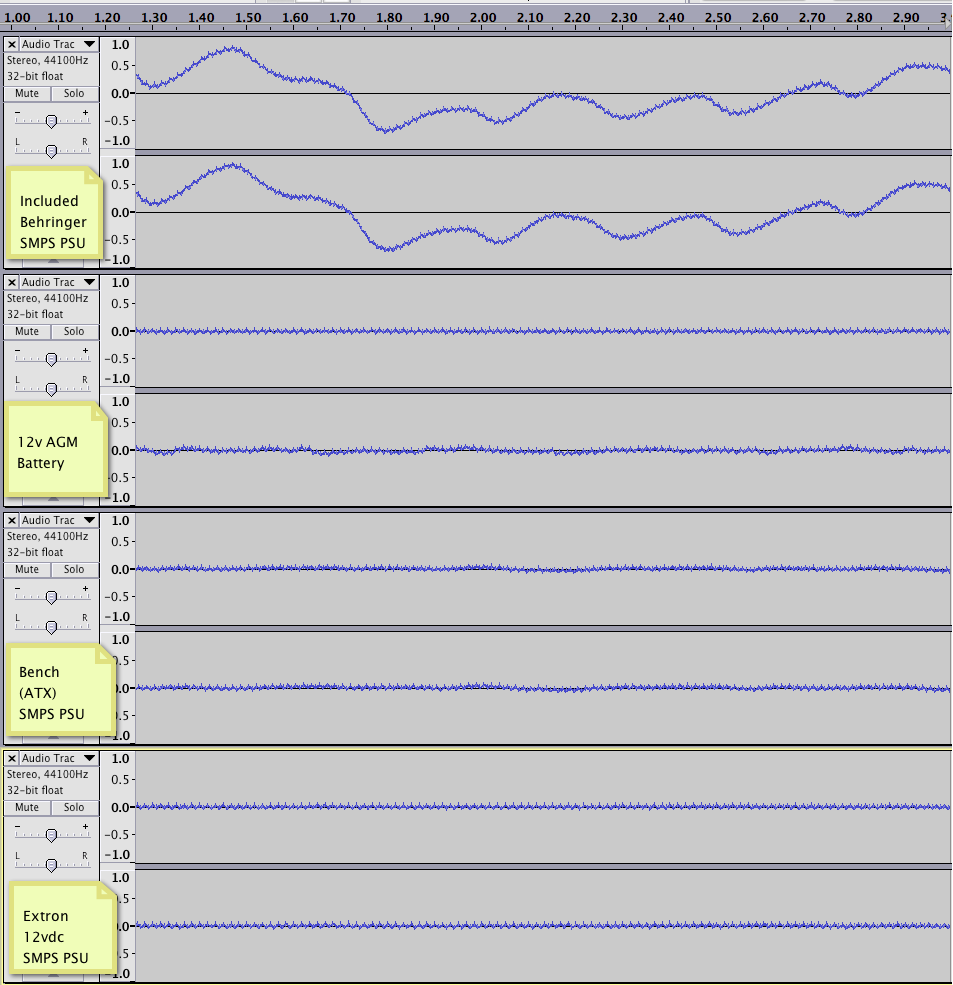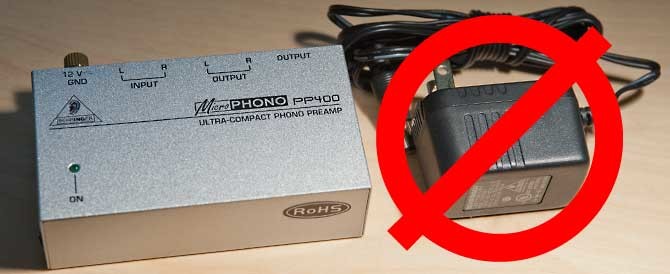Strange case of the Behringer PP400 MicroPHONO
I’ve recently started turning my pretty-decent and long-missed LP collection into MP3 and FLAC files. Bring on the Tangerine Dream, Berlin-era Bowie and UK!
I’d bought a Behringer PP400 MicroPHONO RIAA Phono Preamp to get the signal to a level where my Focusrite Sapphire 14 recording interface would get a good capture.
Unfortunately, when I started recording LPs, the Vinyl Studio app would never sense silence before tracks or after the recording ended. I kept seeing the computer-screen VU meters flickering up and down in the quiet part of the display every few seconds. I couldn’t hear it in the sound; the noise-floor seemed constant.
I thought about a lot of possible problems: The dual op-amp inside the MicroPHONO might be oscillating, there could be some strange magnetic interaction between the spinning turntable platter and the cartridge, my Focusrite interface could’ve gone South (I sure hope not!), some oscillation due to the length of my RCA cables, RFI from the dying neon light in my power strip, the MicroPHONO could just be complete crap…lots of options.
In fact, I was able to identify the culprit: the MicroPHONO’s tiny power supply (known also as a Wall-Wart, a Switching Mode Power Supply (SMPS), or “the thing you plug in the wall!”).
In general, I like SMPSs – they’re responsible for a lot of energy savings, lower shipping weight, and use less steel – all of which reduce our carbon debt a little bit. SMPS Wall-Warts are much lighter than the old-school line-transformer-based Wall-Warts. If you give your Wall-Wart a heft and it feels pretty light, you’ve probably got an SMPS. If not, you’ve probably got a line-transformer power supply (and an energy hog).
This Behringer SMPS, however is pretty beat. It is doing some kind of strange cycling thing in the 1-3Hz range (switching power supplies cycle, but usually in a range far above human hearing, not down at 1Hz), and that cycling is leaking through the MicroPHONO and into my Saffire interface, where it’s being faithfully recorded.
Once I narrowed things down, I tried some alternatives: a 12vdc AGM battery, my bench power supply (really, an ATX computer power supply), and an Extron supply I have hanging around from an old surplus buy. Both the bench power supply and the Extron are SMPSes. Check the graphic:

Note that this display is not from a digital oscilloscope, but instead from Audacity – these are audio recordings.
I connected 4 different power supplies to the MicroPHONO, and grabbed about 3 seconds of silence with each via the Saffire 14. Each sample was boosted the same 45dB, so the waveforms would be big enough to see. Samples 2-4 were done with the top off the unit so I could clip the power leads onto it.
Look at the first signal flopping around! How crummy! I think the tiny high-frequency wave in the noise floor of all the supplies is the expected 60Hz hum, perhaps via the phono cartridge.
I’ve read reports of the MicroPHONO throwing Sony receivers into PROTECT mode. The current at the input that this cycling provides might be enough to do so.
If your amp or receiver doesn’t shut down, have a look at your speaker cones: depending on how your amp is coupled, you could be slowly throwing the cones around with the phono preamp. Not good.
The MicroPHONO is not perfect, but it’s not such an awful phono preamp. There must’ve been worse crap in just about everything back in the day. Sure it has an audible noise floor, but that’ll be swamped by LP surface noise anyway.
But if you’ve got this 1-3Hz cycling going on, you wanna ditch the little included Wall-Wart tout de suite and hook up something that can actually provide a stable 12vdc.
You might splice the plug from the Behringer Wall-Wart onto a known-good 12vdc supply, or try another 12vdc center-positive Wall-Wart (careful: watch the polarity!) or see if you can get any support at all from Behringer to get a working SMPS. (Most companies will send you another unit of what’s not working ’cause the left hand doesn’t know what the right does).
Now go fix it and pick your favorite vinyl to recover!

July 9, 2022 @ 10:31 am
Hi, I tried using a cleaner 12v power source (Thurlby) but alas it was still the same. My issue was resolved when I noticed the Technics SL-QD33 TT’s power cable was not earthed. It has an independent earth port on the rear and once that was tied down to the amp and mains earth all is well.
July 9, 2022 @ 11:18 am
Good tip – thanks for posting.
My ancient Pioneer DD turntable has an independent ground (earth) wire that goes down the cable with the left and right channels, and back in the day, just about any turntable would’ve had this, or a separate ground wire.
The Behringer MicroPHONO has a ground post on the back just for the purpose. I’d hooked it up with the turntable ground, and didn’t think twice about mentioning an ungrounded turntable/cartridge shell as a potential source of interference.
It sure is, and people with noise trouble should check for a missing turntable ground/earth first.